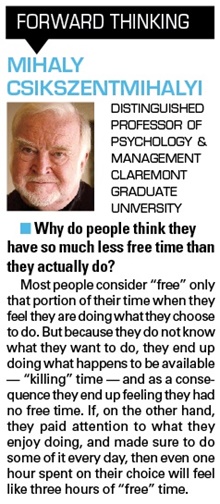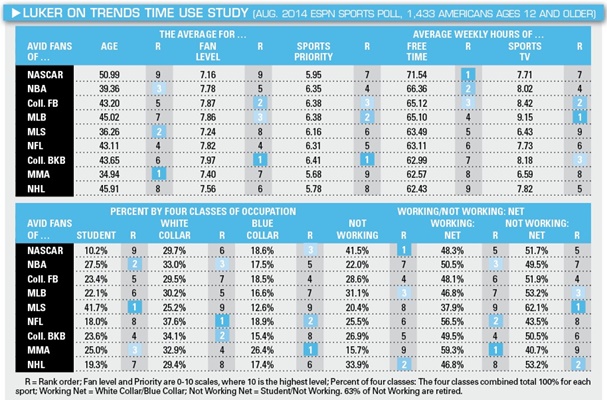A car is made of steel, rubber, glass and wire. A sports fan is made of free time.
You have nine hours of free time every day. Well, not you, but the typical American. And not exactly “free.”
In the August 2014 Free Time Use Study from Luker on Trends-ESPN Sports
Poll, we did not ask people to guess how much free time they had. Rather, we measured their productive hours (work, school, sleep, etc.) and subtracted that from the 168 hours there are in a week. The average American age 12 and older has just over nine hours of free time left in a day. Most Americans think they have two to three hours.
Mihaly Csikszentmihalyi is one of the world’s foremost time-use researchers and author of “Flow: The Psychology of Optimal Experience.” I asked him why there is such a difference between the free time we have and what we think we have. His answer (see Forward Thinking, below) pointed to the power and potential of free time well-invested. If we have nine hours of free time and think we have two or three, that leaves six or seven hours a day unaccounted for. We can kill that time, we can plan what we do, or we can make commitments with our free time.
If, on a whim, you play catch with your daughter, that’s free time. If she plays in a league that has 15 games a season, that is a commitment for her and no longer free time. If you have to take her to and from games and practices, that is a commitment for you, too. Free-time commitments are not required for a person to live, but they are solid evidence of what is most important in life.
Who has free time? Retired people have the most, and children younger than 17 second most. White-collar workers (professionals, managers, owners, engineers, etc.) have the least free time. Male white-collar workers ages 18-54 have the least of the least. After that, in general, 18- to 34-year-olds have the least free time — and they report watching the least sports on TV or online.
And that is exactly what makes them such a precious media audience.
Men 18-34 are hard to reach. Period. That they are less active in sports compared with other people isn’t a problem. That they watch as much sports on TV/online as they do is rather amazing given they average two hours a day less free time than other adults.
Having more free time doesn’t automatically translate to more engagement in free time activities like sports. For example, avid NASCAR fans have more free time than fans of the other eight sports in the charts at left, but they are last in fan level, seventh in the extent to which sports is a priority, and seventh in the amount of sports, in general, they watch on TV. Nearly twice as many avid NASCAR fans (41.5 percent) are not working (retired, unemployed, or stay-at-home parents) than is true for fans of any of the other sports — which adds to free time, but not in ways that predict a higher priority is given to sports.
NFL avid fans are sixth in free time, first in the percentage who are white-collar workers, and second in the percentage of avid fans who are working (56.5 percent, white- or blue-collar). They have an hour a day less free time than avid NASCAR fans but watch just a bit more sports on TV. Sports TV is a higher priority for them than avid NASCAR fans.
Avid college basketball fans are seventh in free time. They are second to the NFL in percentage of white-collar workers who have the least free time, but avid college basketball fans are at the top in fan level and sports priority. That translates to the third highest sports viewing levels — proof of that priority. Active life, plus less free time, plus high interest and sports priority leads to, perhaps, the most important kind of sports viewing. When you have less free time, you are less likely to kill it, more likely to plan what you do, and even more likely to commit to things that are a higher priority to you. March Madness works not just because it is a good idea. It works because the fan base prioritizes sports involvement more than fans of other sports.
Sports fans are made of free time, but it isn’t the amount of free time that tells the story. It is the prioritization of that time that matters. In the same way that the 18-34 audience is so valuable because their time is so rare, we can do a whole lot more to move people from killing time with sports to planning sports involvement and to committing to sustained sports activity. Imagine how much more could be done strategically by better understanding how fans think of and use their free time in sports.
Rich Luker (rich@lukerco.com) is the founder of Luker on Trends and the ESPN Sports Poll.








